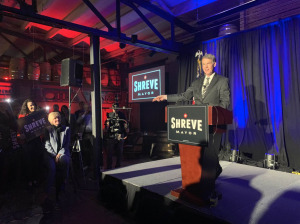Subscriber Benefit
As a subscriber you can listen to articles at work, in the car, or while you work out. Subscribe Now
Hefty self-funding for TV and radio ads combined with strong messaging against the incumbent Democratic mayor catapulted Jefferson Shreve to victory over his strongest opponent Tuesday night in the Republican primary for Indianapolis mayor.
Shreve declared victory at about 8:40 p.m. with 75% of the voting centers reporting. He had 66% of the vote and his closest competitor, Abdul-Hakim Shabazz, had 26%.
Shreve’s win sets up a November election battle against two-term incumbent Joe Hogsett, who won the Democratic primary and has been Shreve’s main target throughout the primary election season.
Shreve focused on crime prevention in his acceptance speech as he did throughout the campaign, saying Marion County voters have “voted with their feet” by leaving the county due to feeling unsafe.
“It is no way for citizens of our city to live, and it is no way for the mayor of our city to lead,” Shreve said. “And I will change that.”
Shreve, a former city-county councilor, spent $1.4 million in the pre-primary period, a figure considered to be the most spent in a Republican primary for Indianapolis mayor. Shreve, who last year sold his self-storage company for $590 million, gave his campaign at least $2.5 million of his own funds.
He spent much of his campaign money on commercials that focused heavily on crime and what he called Hogsett’s “failure” to address it.
Shabazz was well known from roles hosting a radio show on 93.1 WIBC-FM, being a frequent panelist on local politics shows, and publishing IndyPolitics.org.
Media outlets suspended his political commentator roles for the duration of the campaign out of fairness to the other candidates.
Shabazz also faced criticism for some of his previous hot takes on local politics. The Marion County Democratic Party slammed Shabazz for a column in which he said Indianapolis could become a “self-cleaning oven” if criminals were allowed to kill each other.
Shabazz said he is looking forward to maintaining a positive relationship with Shreve.
“Hard campaigning doesn’t necessarily mean hard feelings going forward,” Shabazz said.
Shreve is backed by some high-powered Republicans who believe his city government experience and his ability to self-fund his campaign could give the party its best shot ever at taking down Hogsett.
Mark Lubbers, a highly regarded political operative and close adviser to former Gov. Mitch Daniels, has been providing Shreve with guidance in an unofficial capacity throughout the campaign. Eric Cullen, former campaign manager for U.S. Sen. Todd Young, helped launch Shreve’s campaign.
“I’ve been able to attract a talented team because they see something in me that they’re buying into,” Shreve told IBJ in April.
Please enable JavaScript to view this content.

At least Abdul would’ve made this race entertaining.
+1
Shreve had some real good political ads on local crime.
Shreve was tightly scripted and used fear to win the support of red voters, painting the challenges Indianapolis faces with a broad brush that was short on actual facts.
For instance, he claims in this story that citizens are leaving the city for safer suburbs (his TV spots hammered Hogsett on the crime issue). Yet census data doesn’t back that assertion up. He’ll have to sharpen his focus on a wider variety of issues – supported by facts – if he has any hope for winning over the Democratic majority.
The 2020 Census reports (a statistically supported survey) show 887,642 people.
The July 1, 2021 estimate shows 882,039.
I’ll at least admit that this population drop might be statistically insignificant and is probably less than many other cities. But it certainly doesn’t show that citizens are flocking to the city.
I think 2020/2021 should definitely be taken with a grain of salt. And even beyond the obvious, sometimes the year-to-year reports end up being really off or at least balanced out when the Census is takne.
Lol…
Do you really think people aren’t moving out because of high crime and
poor schools??
People that can afford to leave will.
Indianapolis is losing population.
So, Indianapolis population:
2021 882,039 15 -0.6% (Non-Census years, like this, are usually inaccurate — as revealed when the actual Census takes place.)
2020 887,382 15 0.8% (Actual Census)
2010 820,445 12 0.5% (Actual Census)
2000 782,254 12 0.7% (Actual Census)